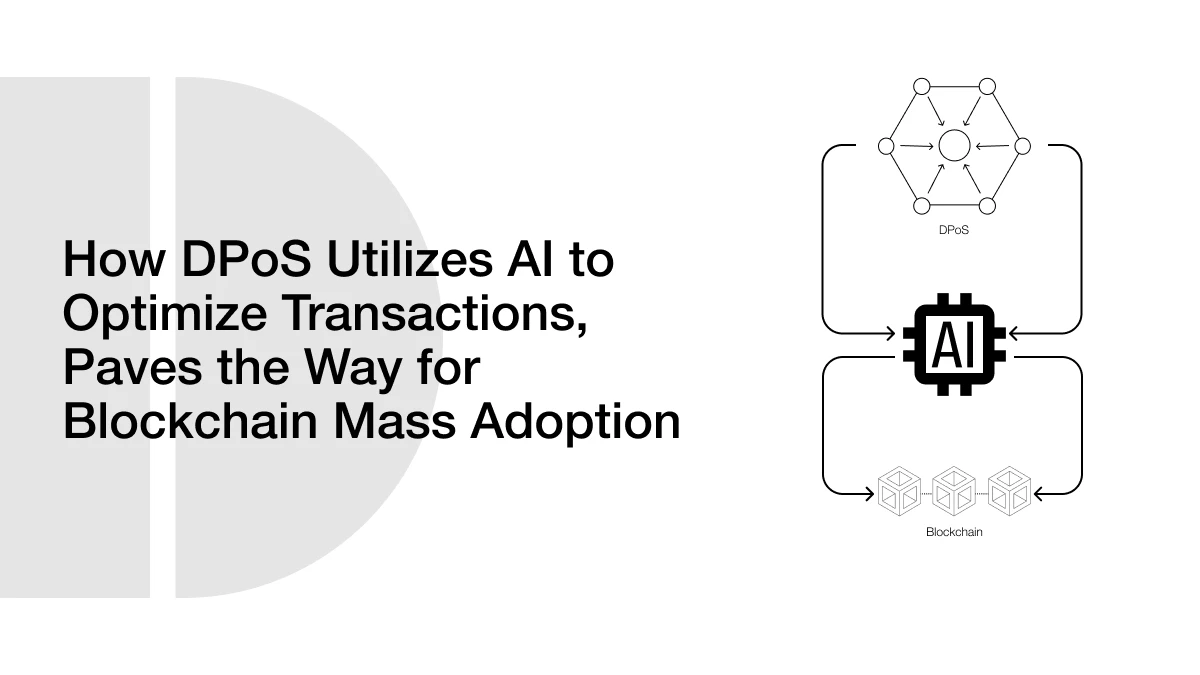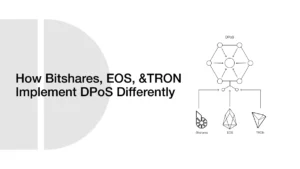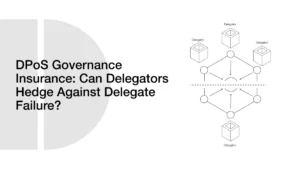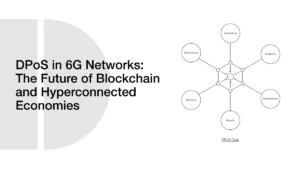How DPoS Integrates AI for Transaction Optimization, Ensures Mass Adoption for Blockchains

Blockchain technology is now a mainstream, disruptive infrastructure that provides the foundation of finance, healthcare, supply chains, and decentralized applications. Nonetheless, with the rising rate of adoption, the requirements of blockchain performance are growing. Conventional consensus protocols, such as Proof of Work (PoW) and Proof of Stake (PoS), are becoming increasingly incapable of supporting applications with high throughput and speed, particularly intelligent automation applications, including smart cities, the Internet of Things (IoT), and high-frequency trading platforms.
- What Is Delegated Proof of Stake (DPoS)?
- Definition and Origin
- How DPoS Differs from Other Consensus Mechanisms
- Comparison with Proof of Work (PoW)
- Comparison with Proof of Stake (PoS)
- Core Components of DPoS
- Challenges in Blockchain Transaction Efficiency
- AI’s Role in Optimizing Blockchain Transactions
- Why AI Matters for Transaction Performance
- Why DPoS Is Ideal for AI Transaction Optimization
- How DPoS Enables AI to Optimize Blockchain Transactions
- Smarter Delegate Selection with AI
- Faster Transaction Finality Through Smart Block Scheduling
- Real-Time Threat Detection for Safer Transactions
- Real-World Applications and Case Studies
- EOS: AI-Assisted Delegate Governance
- TRON: Smart Contract Analytics and Delegate Automation
- DPoS Chains and Their AI-Enhanced Features
- AI Use Cases in Smart Contracts on DPoS Chains
- The Final Word
- Frequently Asked Questions (FAQs)
- Glossary of Key Terms
The main issue behind this performance deficit is transaction optimization. What are the methods of blockchain systems to support thousands of transactions per second without violating security, decentralization, and privacy? Here, the Delegated Proof of Stake (DPoS) presents an interesting concept, particularly when combined with Artificial Intelligence (AI).
As a blockchain developer, researcher, or tech strategist, it is crucial to navigate the upcoming decade of decentralized innovation effectively. This blog will examine the role of DPoS in facilitating AI-based transaction optimization on the next-generation blockchains.
What Is Delegated Proof of Stake (DPoS)?
Delegated Proof of Stake (DPoS) is a consensus mechanism designed to increase the speed, efficiency, and democratization of blockchain networks. First proposed by Daniel Larimer in 2014 when creating BitShares, DPoS has since been adopted by various large blockchain platforms, including EOS, TRON, and Lisk, which utilize the mechanism to provide a scalable and low-latency transactional environment.
In contrast to Proof of Work (PoW), which is based on solving mathematical puzzles, and Proof of Stake (PoS), where validators are chosen based on the amount of tokens they hold, DPoS involves an election. The holders of tokens vote on a fixed number of delegates referred to as block producers or witnesses who are given the mandate to validate transactions and ensure the integrity of the blockchain.
ALSO READ: How to Integrate Smart Contracts with DPoS-Based Blockchains
This level of governance enables the consensus mechanism to be a fast, low-energy, and highly flexible system, paving the way for the introduction of intelligent automation and the easy integration of artificial intelligence.
Definition and Origin
DPoS is a representative consensus mechanism. The holders of the tokens aren’t directly involved in the validation of the block, but they outsource the task to representatives who are elected by them. Such an approach enables the integration of blockchain decentralization and participation in the governance process. Therefore, the system operates efficiently and is not separated by the opinion of the community.
- Every user in the network holds tokens that represent voting power.
- Token holders vote for a limited number of delegates (typically 21 to 100).
- These delegates take turns producing blocks in a round-robin schedule.
- Misbehaving or underperforming delegates can be voted out at any time.
How DPoS Differs from Other Consensus Mechanisms
| Feature | Proof of Work (PoW) | Proof of Stake (PoS) | Delegated Proof of Stake (DPoS) |
| Block Validation | Miners solve puzzles | Stakers validate based on stake | Delegates elected by token holders |
| Energy Consumption | Very high | Moderate | Very low |
| Speed | Low (7–20 TPS) | Medium (50–500 TPS) | High (up to 10,000+ TPS) |
| Security | Strong, but costly | Good, depends on stake | Strong, with real-time voting |
| Governance | None | Limited | On-chain voting and participation |
| Scalability | Poor | Moderate | Excellent |
*TPS = Transactions Per Second
Comparison with Proof of Work (PoW)
Proof of Work (PoW) has been used as the basis of early blockchains such as Bitcoin, providing strong security based on computational challenges. Nevertheless, this advantage has a price:
- The estimated amount of electricity consumed by Bitcoin is 120 TWh per year, or ~707 kWh per transaction (Cambridge Bitcoin Electricity Consumption Index, 2024).
- Network scalability is constrained by long block times and global propagation delays.
- The process encourages centralization, as only entities with vast computational resources can compete effectively.
In contrast, DPoS eliminates mining entirely. Delegates use digital signatures and deterministic scheduling to create blocks, vastly reducing energy consumption and environmental impact.
According to research from Kumamoto University, DPoS systems, such as EOS, consume as little as 0.001 TWh per year, making them among the most environmentally friendly consensus protocols in blockchain today (IBM Blockchain Whitepaper, 2022).
Comparison with Proof of Stake (PoS)
Proof of Stake (PoS) avoids the energy burden of PoW by selecting validators based on stake size. While this is more efficient, it still has downsides:
- Wealthier participants disproportionately influence consensus.
- Long-term token holders may not actively engage in governance.
- Latency and throughput remain limited in most PoS implementations.
Delegated Proof of Stake (DPoS) resolves these issues by layering delegated governance over PoS like economics. Token holders don’t need to be technically capable or constantly online; they simply elect competent delegates to manage the network. The result is a scalable, democratic, and resilient consensus layer.
ALSO READ: From Elections to Blockchain: How DPoS Works in the Real World
Moreover, AI algorithms can be trained on voting patterns, delegate behavior, and transaction metrics to:
- Recommend optimal delegate rotations.
- Predict slashing scenarios.
- Monitor systemic health metrics in real-time.
This adaptability is something neither PoW nor PoS natively supports.
Core Components of DPoS
1. Stakeholders
Anyone holding tokens in the network. Stakeholders use their holdings as votes in the election of delegates. Voting power is usually proportional to stake.
2. Delegates (Block Producers)
Elected representatives who:
- Validate transactions
- Generate blocks
- Propose protocol upgrades
- They are held accountable by voter scrutiny
3. Voting Mechanism
The electoral process varies by implementation but typically includes:
- Real-time or periodic voting
- Proxy voting (delegating your vote to someone else)
- Transparent delegate performance metrics
This structure allows DPoS to dynamically respond to network conditions and stakeholder preferences, making it an excellent foundation for AI-assisted governance and optimization.
Challenges in Blockchain Transaction Efficiency
Blockchain networks face a significant challenge as they scale, as they must handle transactions efficiently. The classical consensus mechanisms, such as Proof of Work (PoW) and Proof of Stake (PoS), are slow, with a typical performance of tens of transactions per second. This bottleneck limits the use of blockchain in industries such as finance, IoT, and supply chain, where throughput is crucial.
The first is latency, or the amount of time that it takes to confirm and broadcast transactions throughout the network. This delay in PoW is attributed to computational mining; in PoS, it is attributed to sequential validator selection. Scalability is another issue, especially when the block size or the number of delegates is fixed and cannot be adjusted to meet increased demand. Additionally, there is a dilemma between network security and speed optimization. The rapid consensus may lead to centralization risks, while slower networks impact the user experience.
DPoS proposes a possible solution in which block production is delegated to a small set of trusted nodes, although even this system can become overloaded during periods of high load. Artificial intelligence (AI) plays a role, providing predictive analytics, dynamic load balancing, and anomaly detection to enhance throughput and responsiveness. In short, optimizing transaction efficiency requires more than just faster consensus; it demands intelligent orchestration, which AI-integrated DPoS is uniquely equipped to deliver.
AI’s Role in Optimizing Blockchain Transactions
As blockchain adoption expands across payments, DeFi, and enterprise-grade infrastructure, the challenge of achieving transaction efficiency becomes increasingly urgent. Static rule-based consensus mechanisms like PoW and even standard PoS are simply not equipped to make real-time decisions based on fluctuating network conditions. This is where Artificial Intelligence (AI) reshapes the equation.
Why AI Matters for Transaction Performance
At their core, most blockchain networks execute smart contracts and confirm transactions according to predefined logic. Once deployed, these protocols rarely adapt. But transaction demand isn’t static. It fluctuates due to time zones, user behavior, and even geopolitical events.
AI introduces dynamic adaptability to these networks. Using real-time data, AI models can analyze transaction pools, prioritize urgent transfers, identify anomalies, and route traffic more efficiently. This enables the blockchain to:
- Clear congestion dynamically instead of queueing blindly
- Prioritize transactions with contextual awareness (e.g., real-time gas estimation, payment urgency)
- Detect fraud patterns early and adjust delegate behavior accordingly
Why DPoS Is Ideal for AI Transaction Optimization
Delegated Proof of Stake (DPoS) is the most AI-friendly consensus mechanism architecture. The smaller set of validators enables shorter feedback loops, allowing for real-time AI tuning of delegate choice, block scheduling, and load balancing.
Unlike PoW, which is rigid and energy-intensive in nature, or PoS, which can be opaque and stake-biased, DPoS is modular in nature. All processes, including voting, validation, and governance, are transparent and quantifiable. Hence, they are ideal for optimization with the help of AI.
AI Method |
Optimization Focus | Blockchain Benefit |
| Reinforcement Learning | Adaptive block scheduling | Reduces latency under dynamic loads |
| Deep Learning | Anomaly and fraud detection | Improves network security |
| Federated Learning | Edge data processing | Enables privacy-preserving scalability |
| Decision Trees | Vote manipulation pattern detection | Prevents collusion and voting fraud |
| Neural Architecture Search | Smart contract code generation | Boosts efficiency and reduces gas costs |
How DPoS Enables AI to Optimize Blockchain Transactions
Among various blockchain consensus models, Delegated Proof of Stake (DPoS) stands out as the most compatible architecture for integrating artificial intelligence. Its streamlined validator structure, predictable scheduling, and transparent governance create a modular environment where AI can intervene meaningfully. Rather than relying on rigid rules, DPoS systems can incorporate dynamic AI models to analyze real-time network data and optimize the processing, validation, and confirmation of transactions.
ALSO READ: Is DPoS the Future of Scalable Governance in Blockchain?
As blockchain networks expand to support complex applications, such as decentralized finance and global payments, latency and transaction reliability become top priorities. In this landscape, AI-enabled DPoS offers a practical path forward. By embedding intelligence into consensus mechanics, DPoS allows blockchain infrastructure to make smarter, faster decisions, reducing confirmation times, minimizing block production failures, and protecting the network from malicious behavior.
Smarter Delegate Selection with AI
Traditional DPoS relies on token-weighted voting to elect delegates, which can lead to favoritism or inefficiency. AI adds a performance-driven layer to this process by scoring and ranking delegates based on historical reliability, latency, uptime, and network responsiveness. Deep learning and graph-based models can identify underperforming delegates or patterns of negligent behavior well before those delegates impact block production or transaction finality.
This approach is especially critical in time-sensitive environments, such as DeFi or international settlements, where even a single second of delay can lead to slippage or failed transactions. A simulation by the University of Glasgow demonstrated that using AI-enhanced delegate scoring resulted in a 22 percent reduction in block production failures. This results in fewer delays, faster confirmations, and a stronger guarantee of transaction processing for users.
Faster Transaction Finality Through Smart Block Scheduling
In standard DPoS implementations, blocks are produced in a round-robin fashion without regard to real-time conditions. This deterministic order, while efficient in ideal settings, fails to respond to sudden spikes in network activity, node latency, or temporary outages. AI changes this dynamic by enabling real-time optimization of the delegate rotation schedule through reinforcement learning models.
These models evaluate current transaction queue lengths, node processing speeds, and regional latency to determine the most effective order for block production. Instead of forcing a slow or overloaded delegate to process a block, the AI scheduler can recommend a better candidate on the fly. This responsiveness directly translates into faster transaction finality, lower failure rates, and a smoother user experience when interacting with blockchain-based apps and services.
Real-Time Threat Detection for Safer Transactions
Even with DPoS’s layered governance, the system isn’t immune to insider threats, such as collusion or vote buying. AI provides an additional layer of security by constantly monitoring transaction flows and validator behavior for anomalies. Neural networks such as LSTM or autoencoders can be trained to detect subtle behavioral shifts that precede attacks or performance failures.
Combining AI with real-time reputation systems enables it to initiate automatic alerts, halt suspicious validators, or suggest emergency delegate replacements before any impact on transaction processing occurs. This strengthens network trust and ensures continuous uptime for high-stakes applications. For the crypto community, this translates to fewer disruptions, a reduced risk of double-spending, and a safer environment for both developers and end-users.
AI Use Cases in DPoS Optimization
| Use Case | AI Method | Outcome |
| Delegate scoring | Deep learning (DNN) | Removes bad actors proactively |
| Block scheduling | Reinforcement Learning | Reduces average block latency |
| Energy usage tuning | Federated Learning | Cuts consensus energy overhead |
| Threat detection | LSTM / Autoencoders | Flags attacks with >90% accuracy |
| Vote fraud detection | Decision Trees | Prevents vote-buying & manipulation |
Real-World Applications and Case Studies
Real-world blockchain implementations are increasingly realizing the theoretical connection between AI and DPoS. This section highlights three leading projects—EOS, TRON, and Lisk—to demonstrate how DPoS consensus benefits from AI integration, improving performance, governance, and developer accessibility.
EOS: AI-Assisted Delegate Governance
EOS is one of the earliest and most widely recognized blockchains to implement Delegated Proof of Stake at scale. Its network consists of 21 elected block producers, chosen continuously by token holders through a dynamic voting process.
In recent iterations, EOS has begun integrating AI models for:
- Real-time scoring of block producers based on historical uptime and transaction inclusion rates.
- Spam detection in microtransaction-heavy applications.
- Predictive scheduling to minimize network latency during periods of high load.
Block producers are required to publish infrastructure benchmarks, which AI systems analyze to predict performance degradation. A collaborative project between developers and researchers at the College of Mechanical Engineering, Chongqing University of Technology, demonstrated a 12% throughput gain using reinforcement learning in scheduling EOS delegates under simulated high-volume conditions (Algorithms, 2025).
TRON: Smart Contract Analytics and Delegate Automation
TRON also runs on a DPoS model, featuring 27 Super Representatives (SRs) elected by TRX token holders. It processes over 2,000 transactions per second and hosts a growing ecosystem of smart contracts and decentralized applications (dApps). According to findings by researchers at the Shibaura Institute of Technology in Japan, TRON’s anomaly detection models, trained on years of contract and voting data, were able to flag over 85% of historical malicious behavior in testnet simulations, improving governance responsiveness by 30%.
To scale efficiently, TRON integrates AI in the following ways:
- Behavioral analysis of delegates: Deep learning algorithms predict the likelihood of a delegate missing a block or submitting faulty transactions.
- AI-enhanced contract analytics: Smart contracts are scanned using NLP and neural networks to identify inefficiencies or vulnerabilities before deployment.
- Automated fraud detection: TRON utilizes LSTM models to identify sudden changes in network behavior, such as vote buying or flash attacks.
DPoS Chains and Their AI-Enhanced Features
| Blockchain | DPoS Role | AI Integration Focus | Performance Impact |
| EOS | 21 block producers | Delegate scoring, block scheduling, load prediction | +12% throughput, lower missed block rate |
| TRON | 27 Super Representatives | Smart contract scanning, fraud detection, voting integrity | +85% anomaly detection, +30% governance efficiency |
AI Use Cases in Smart Contracts on DPoS Chains
| AI Function | Smart Contract Impact | Example Application |
| GNN Vulnerability Detection | Identifies bugs with 35% higher accuracy | DAO attack prevention (ETH, EOS) |
| NAS for Logic Restructuring | Reduces gas usage by 20–30% | TRON DeFi contract acceleration |
| ML-Based Access Control | Dynamic permissions for users | NFT platform anti-bot systems |
| XAI Interpretability | Transparent governance decisions | RegTech-ready DAOs |
| Federated Learning | Private data analysis | Healthcare insurance contracts (Lisk sidechains) |
The Final Word
The convergence of Delegated Proof of Stake (DPoS) and Artificial Intelligence (AI) represents a pivotal shift in how next-generation blockchains will scale, govern, and secure decentralized ecosystems. Where DPoS brought democratic performance optimization through elected validators, AI now equips these networks with adaptive intelligence, making consensus faster, smarter, and more resilient.
The integration of Delegated Proof of Stake and artificial intelligence will define how scalable, sustainable, and secure decentralized systems truly become. DPoS provides the structure. AI provides the intelligence. Together, they unlock a new class of blockchain performance that no single technology could achieve on its own.
For developers, architects, and investors, now is the time to build and invest in intelligent, DPoS-based systems that lead the way in governance, scalability, and trustless automation.
Frequently Asked Questions (FAQs)
- What is Delegated Proof of Stake (DPoS)?
DPoS is a consensus mechanism where blockchain users vote for a small group of delegates to validate transactions and create blocks on their behalf. It offers faster performance and greater energy efficiency than PoW or PoS.
- How does AI improve blockchain performance?
AI enhances blockchain by optimizing delegate selection, detecting fraud, reducing latency, automating smart contract validation, and improving privacy through federated learning.
- Why is DPoS more suitable for AI integration than PoW or PoS?
DPoS has fewer validators, a predictable schedule, and measurable governance data, all of which make it easier to train and apply AI models in real-time.
Glossary of Key Terms
| Term | Definition |
| DPoS (Delegated Proof of Stake) | A consensus algorithm where users elect delegates to validate blocks. |
| AI (Artificial Intelligence) | The use of algorithms to simulate human decision-making and learning. |
| PoW (Proof of Work) | A consensus mechanism based on solving computational puzzles. |
| PoS (Proof of Stake) | A consensus model that assigns block creation based on token holdings. |
| Reinforcement Learning (RL) | A type of AI where agents learn optimal behavior through feedback and rewards. |
| Federated Learning (FL) | A privacy-preserving ML technique where models are trained locally across devices. |
| Smart Contract | Self-executing code deployed on the blockchain with predefined conditions. |
| LSTM (Long Short-Term Memory) | A type of recurrent neural network used for time-series prediction. |
| Neural Architecture Search (NAS) | An AI method for automating the design of neural networks. |
| XAI (Explainable AI) | AI systems are designed to be interpretable and transparent to users and regulators. |




